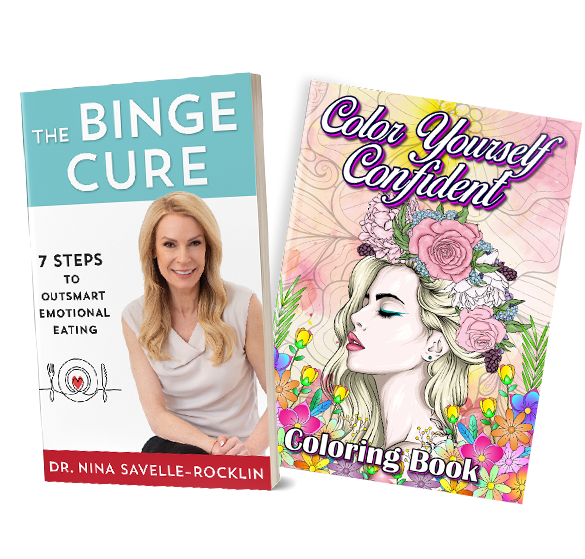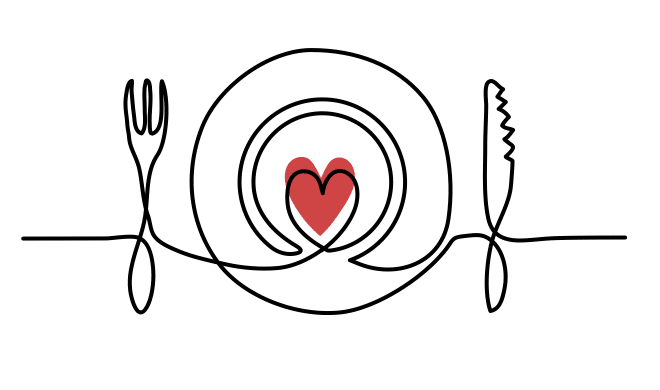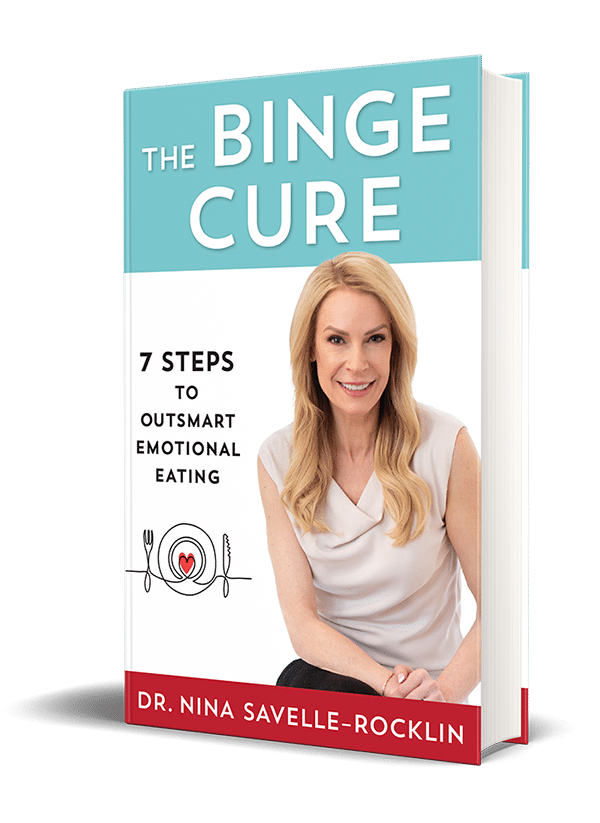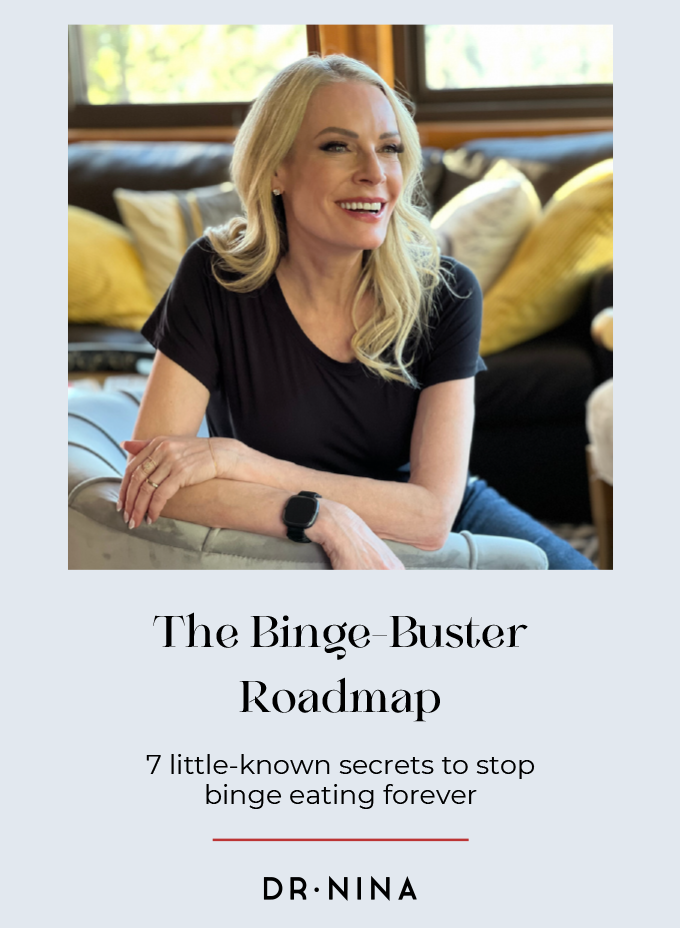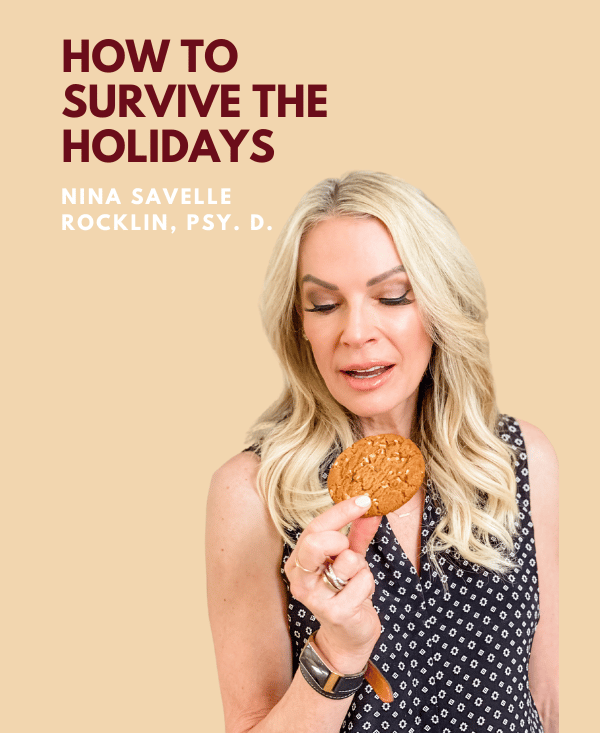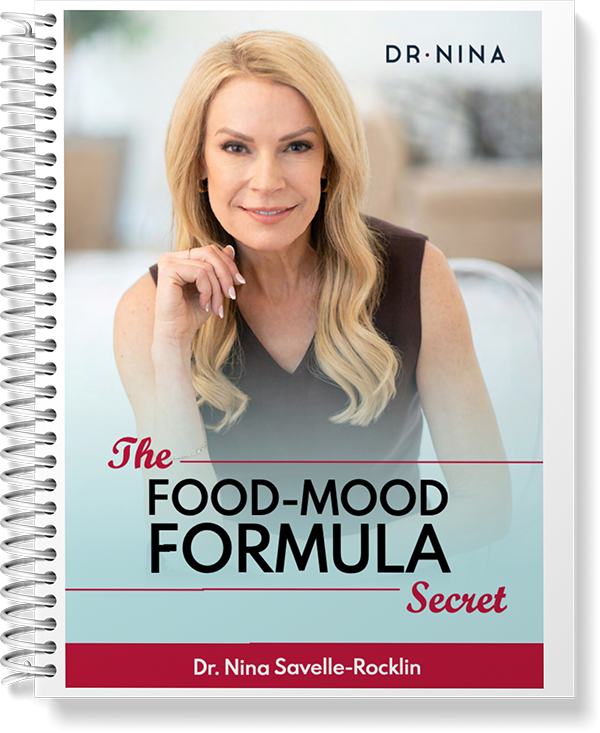Dr. Nina Savelle-Rocklin
Binge Eating Self-Help Guide: How to Go from Self-Sabotage to Self-Control

Table of Contents
- Step 1. Recognize Your Patterns
- Step 2. Understand What Food Represents
- Step 3. Explore the Emotions Behind Your Binges
- Step 4. Express Your Feelings
- Step 5. Self-Soothe with Words
- Step 6. Practice Self-Compassion
- Step 7. Challenge Negative Self-Talk
- Final Thoughts
- Frequently Asked Questions about Binge Eating Self-Help
Whether you’ve been binge eating for years or just feel out of control around food, there are powerful steps you can take to begin transforming your relationship with both food and yourself. The key is to focus on why you’re eating, not just what you’re eating.
Here are seven binge eating self-help strategies that can help you understand your emotional triggers, develop self-compassion, and start creating real change.
Step 1. Recognize Your Patterns
Every pattern begins with a trigger. Maybe you binge when you’re stressed, lonely, or exhausted. Or perhaps you eat in response to specific situations—after arguments, at night, or when you’re alone.
Keep a food and mood journal to identify when and why your binges happen. Write down not only what you eat, but also what you feel and what’s happening around you.
Recognizing your patterns is the first step toward interrupting them. Awareness creates choice, and choice creates change.
Step 2. Understand What Food Represents
So many of our social interactions center around food. We celebrate with birthday cake or a nice restaurant. We eat “comfort food” and reward ourselves with sweets.
So, food plays a symbolic role in our lives and provides comfort, protection, distraction, or reward. The first step to healing is to identify what food represents for you.
Are you seeking comfort? Trying to soothe anger, fear, or sadness? Are you lonely and craving connection? When you discover the emotional meaning behind your eating, you can start meeting those needs in healthier, more fulfilling ways.
In binge eating self-help, this insight is crucial. Once you understand what food symbolizes for you, you can find new, non-food ways to experience those same emotions—security, calm, pleasure, or love.
Step 3. Explore the Emotions Behind Your Binges
You can’t ignore emotions like anger, grief, loneliness, shame, or fear. Nor can you drop them, positive-think them away, or stuff them down.
While it’s commonly thought that it’s important to “sit” through feeling, that can be confusing. The way to process emotions is to identify them and then feel them. First, identify the emotion. For example, “I feel anxious” or “I feel lonely.”
Emotional awareness is a cornerstone of binge eating self-help. The more fluent you become in recognizing your emotions, the less power they’ll have over you.
Step 4. Express Your Feelings
Once you’ve identified what you’re feeling, it’s important to give those emotions a voice. Unexpressed feelings don’t disappear but are often displaced into an urge to eat. For example, if you’re upset at a person in your life, you may turn to food instead and get mad at yourself for binge eating.
To stop binge eating, express your feelings in words, not actions. That means names not only the emotion, but what it means. For example: “I feel sad that no one noticed how hard I worked,” or “I’m angry that I’m always the one taking care of everyone else.”
When you name your feelings and make meaning of them you transform them from something overwhelming into something understandable. That’s what brings relief. Binge eating is a way of distancing yourself from your emotions, but expressing them is what processes them.
Step 5. Self-Soothe with Words
To stop binge eating for good, you’ll need new ways to soothe yourself when you’re upset. That doesn’t mean walking, journaling, or taking deep breaths. Those activities can help momentarily, but they don’t address the real need for emotional soothing.
True self-soothing happens through language. It’s about responding to yourself with words that validate and comfort what you feel. You might say, “Of course I’m upset. That was painful,” or “It makes sense that I feel this way, but I can handle it.”
This internal dialogue is how you become your own source of comfort. When you soothe yourself with words instead of food, you begin to meet your emotional needs directly. When you do that, you don't need food for that purpose.
Step 6. Practice Self-Compassion
If you’ve struggled with binge eating for a long time, chances are you’ve also struggled with self-blame. But healing doesn’t come from punishment, it comes from compassion. You can’t hate yourself into feeling better.
Think about how you’d talk to a friend who felt ashamed after bingeing. Chances are, you wouldn’t berate them or think poorly of them. Instead, you’d offer comfort and compassion. You deserve the same kindness from yourself.
Practicing self-compassion might sound simple, but it’s one of the most powerful binge eating self-help tools available. It builds resilience, reduces shame, and encourages healthier choices.
When you treat yourself with gentleness rather than judgment, you strengthen your ability to recover from setbacks. That inner kindness becomes a stabilizing force that supports lasting change.
Step 7. Challenge Negative Self-Talk
After a binge, it’s easy to spiral into harsh self-criticism: “I blew it again. I have no control.” But negative self-talk fuels guilt and shame, which only perpetuate the cycle.
Try reframing your thoughts. Instead of “I failed,” say, “I had a difficult moment, but I’m learning.” Replace judgment with curiosity: “What was going on for me before I started eating?”
The goal isn’t perfection, it’s progress. You learned to turn to food as a way of coping; now you’re learning to use insight and language instead.
Final Thoughts
Healing from binge eating is a journey of self-discovery, not self-discipline. These seven binge eating self-help steps aren’t about controlling food. They’re about understanding yourself.
When you recognize your patterns, express your feelings, and soothe yourself with words instead of food, you begin to meet your emotional needs directly.
Progress isn’t linear. Some days you’ll feel confident and calm and others might be harder. But every moment of awareness moves you forward.
Frequently Asked Questions about Binge Eating Self-Help
Sick of obsessing about every bite?
GET THE CURE
The Binge Cure Book!
Enter “CURE” to receive a 20% discount.
No, I don’t want access to this terrific resource to help me overcome binge eating.
The Author

Dr. Nina Savelle-Rocklin is a renowned author and podcast host and one of the nation’s leading psychoanalysts known for the psychology of eating. Her signature message of, “It’s not what you’re eating, it’s what’s eating ‘at’ you” has resonated with hundreds of thousands of listeners from around the globe in 40 countries. As founder of The Binge Cure Method, she guides emotional eaters to create lasting food freedom so they can take back control of their lives and feel good in their bodies.
Related Blogs













